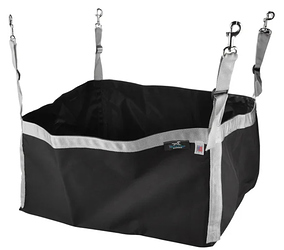We purchased an older horse who did this, but had learned to back out right after last foot stepped on the trailer. After loading quite willingly then coming right back out, husband got a little irritated. Went in the barn to get an old corn broom. He sent her in, when she started back out he put the bristles to her rump. She STOPPED with one hoof in the air, stayed in the trailer while I did up the bar and shut the door.
Well that turned into her loading method. We gave her two in and outs to check the 2H trailer, food at the front, then third time in she had the broom touch to stay in and close the door. She was a very thin-skinned TB, quite sensitive, so firm bristles of the broom were pretty pokey to her. She didn’t even like a firm brush for grooming.
She was not crazy backing out, all quite controlled on her part. Broom poke was quite firm the first couple times, then just needed a touch to stay in. I do not think k you would get the same “feel” using a plastic bristle broom as you get with a real broom-corn bristle broom because broom-corn bristles are much stiffer. I have used the broom on a couple other “quick to exit” horses owned by friends and it worked.
Not sure I would advise tying horse hard-and-fast in the trailer will work well. Can you get him out if he goes up in the Manger or gets a leg over the divider? Do you haul more than one horse at a time? Perhaps removing divider would be safer if you want to try tying solidly. Make sure ropes, snaps, halter are up to the weight and force if he throws himself backwards. Those lead rope snaps are usually only rated for about 100#s. Same problem with rope itself, not rated for 1000# pound stress.
The lunge line out the front, back around his rump is an old method, but DO NOT think you can hold horse by doing this!! You need a snubbing point, perhaps center post in back that won’t break or bend with the force he may give it. Of course a wrap there will makes it harder to shorten the lunge line fast enough. Same considerations, are the line, snap, halter going to hold him if he fights hard? You may want to add a head bumper on a second halter to prevent poll injuries when the head goes up. Second halter with bumper in case he scrapes halter off at the roof edge with high head backing out.
Bad loading horses are a misery to deal with. Hope you can get him retrained to improve his staying in the trailer. My sympathies.

